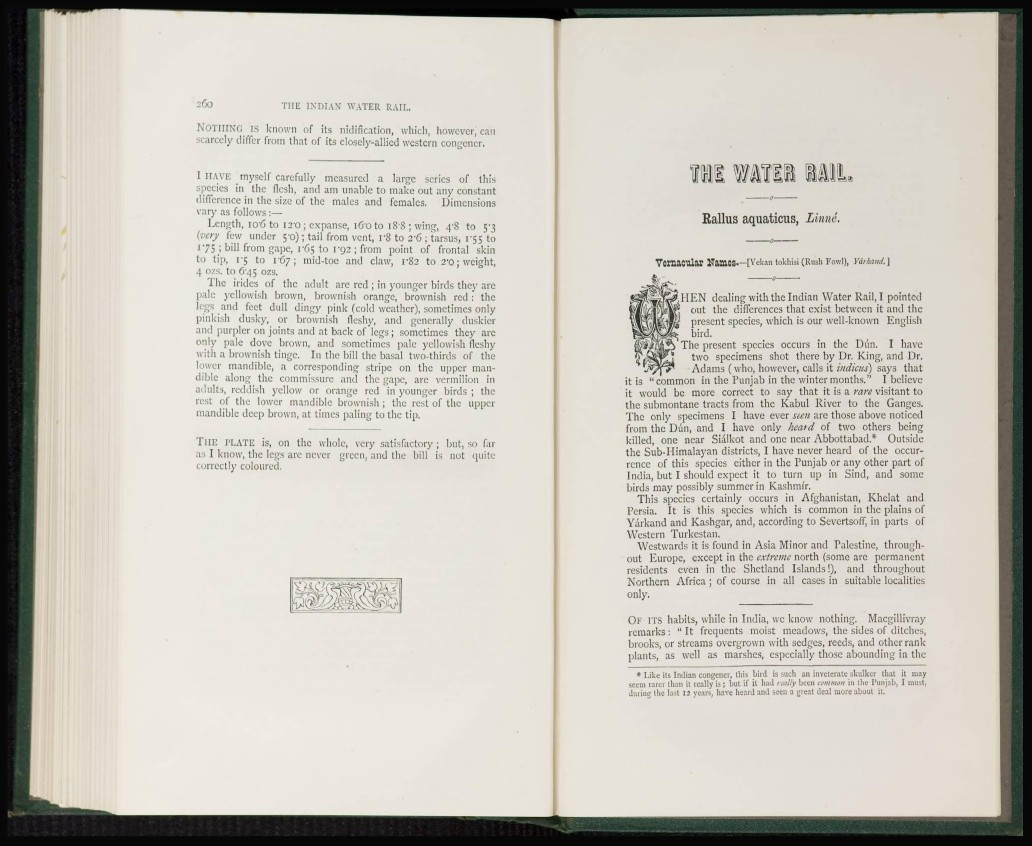
NOTHING IS known of its nidification, which, however, can
scarcely differ from that of its closely-allied western congener.
I HAVE myself carefully measured a large series of this
species in the flesh, and am unable to make out any constant
difference in the size of the males and females. Dimensions
vary as follows :—
Length, ioG to i2'o ; expanse, i6'0 to 18S ; wing, 48 to 5-3
(very few under 50); tail from vent, r8 to 2'C ; tarsus, 1 • 55 to
175 ; bill from gape, 1-65 to i'Q2 ; from point of frontal skin
to tip, i*S to r6y; mid-toe and claw, r82 to 2-0; weight,
4 ozs. to 6'45 ozs.
The hides of the adult are red ; in younger birds they are
pale yellowish brown, brownish orange, brownish red: the
legs and feet dull dingy pink (cold weather), sometimes only
pinkish dusky, or brownish fleshy, and generally duskier
and purplcr on joints and at back of legs ; sometimes they arc
only pale dove brown, and sometimes pale yellowish fleshy
with a brownish tinge. In the bill the basal two-thirds of the
lower mandible, a corresponding stripe on the upper mandible
along the commissure and the gape, arc vermilion in
adults, reddish yellow or orange red in younger birds ; the
rest of the lower mandible brownish ; the rest of the upper
mandible deep brown, at times paling to the tip.
THE PLATE is, on the whole, very satisfactory ; but, so far
as I know, the legs arc never green, and the bill is not quite
correctly coloured.
Wl Wâïli lâiL
Rallus aquaticus, Linné.
Vernacular Names-—[Yekan toklnsi (Rush Fowl), Ydrkctnd. ]
J.HEN dealing with the Indian Water Rail, I pointed
S out the differences that exist between it and the
^ present species, which is our well-known English
^ bird.
The present species occurs in the Dim. I have
two specimens shot there by Dr. King, and Dr.
Adams (who, however, calls it indicus) says that
it is "common in the Punjab in the winter months." I believe
it would be more correct to say that it is a rare visitant to
the submontane tracts from the Kabul River to the Ganges.
The only specimens I have ever seen are those above noticed
from the Dun, and I have only heard of two others being
killed, one near Sialkot and one near Abbottabad.* Outside
the Sub-Himalayan districts, I have never heard of the occurrence
of this species cither in the Punjab or any other part of
India, but I should expect it to turn up in Sind, and some
birds may possibly summer in Kashmir.
This species certainly occurs in Afghanistan, Khclat and
Persia. It is this species which is common in the plains of
Yarkand and Kashgar, and, according to Scvcrtsoff, in parts of
Western Turkestan.
Westwards it is found in Asia Minor and Palestine, throughout
Europe, except in the extreme north (some are permanent
residents even in the Shetland Islands!), and throughout
Northern Africa ; of course in all cases in suitable localities
only.
OF ITS habits, while in India, wc know nothing. Macgillivray
remarks : " It frequents moist meadows, the sides of ditches,
brooks, or streams overgrown with sedges, reeds, and other rankplants,
as well as marshes, especially those abounding ¡11 the
* Like its Indian congener, this bird is such an inveterate skulker that it may
seem rarer than it really is ; but if it had really been common in the Punjab, I must,
during the last 12 years, have heard and seen a great deal more about it.